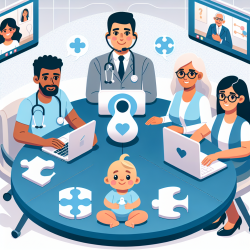Introduction
In the world of speech-language pathology, creating impactful research and therapy outcomes is paramount. A recent study titled Lived experience-centred word clouds may improve research uncertainty gathering in priority setting partnerships explores an innovative approach to enhancing research priority setting through the use of word clouds. This method could be a game-changer for practitioners looking to refine their skills and improve outcomes for children receiving therapy services.
Understanding the Research
The study, conducted by Mowforth et al., utilized word clouds to capture the lived experiences of individuals with degenerative cervical myelopathy (DCM). The aim was to integrate these perspectives earlier in the research priority setting process, traditionally dominated by healthcare professionals. By doing so, the study sought to bridge the gap between patient experiences and research priorities, ensuring that the most pressing issues are addressed.
Implications for Speech-Language Pathologists
For speech-language pathologists, especially those working in online therapy services like TinyEYE, the findings of this study offer valuable insights:
- Enhanced Stakeholder Engagement: Incorporating word clouds in therapy sessions can help practitioners better understand and prioritize the needs of their clients. This approach ensures that therapy goals align closely with the client’s lived experiences.
- Improved Research Prioritization: By using word clouds, practitioners can gather more comprehensive data on client needs, leading to more targeted and effective research questions. This can ultimately improve therapy outcomes and client satisfaction.
- Creative Problem Solving: Word clouds can stimulate creative thinking and problem-solving by highlighting common themes and concerns among clients. This can lead to innovative therapy strategies and interventions.
Encouraging Further Research
While the study provides promising results, further research is needed to explore the full potential of word clouds in speech-language pathology. Practitioners are encouraged to experiment with this tool in their practice and contribute to the growing body of evidence supporting its use. By doing so, they can help shape the future of therapy services and ensure that client needs are met effectively.
Conclusion
Incorporating word clouds into research and therapy practices offers a unique opportunity to enhance the effectiveness of speech-language pathology services. By focusing on client experiences and needs, practitioners can develop more relevant and impactful research questions, ultimately leading to better outcomes for children. To read the original research paper, please follow this link: Lived experience-centred word clouds may improve research uncertainty gathering in priority setting partnerships.










